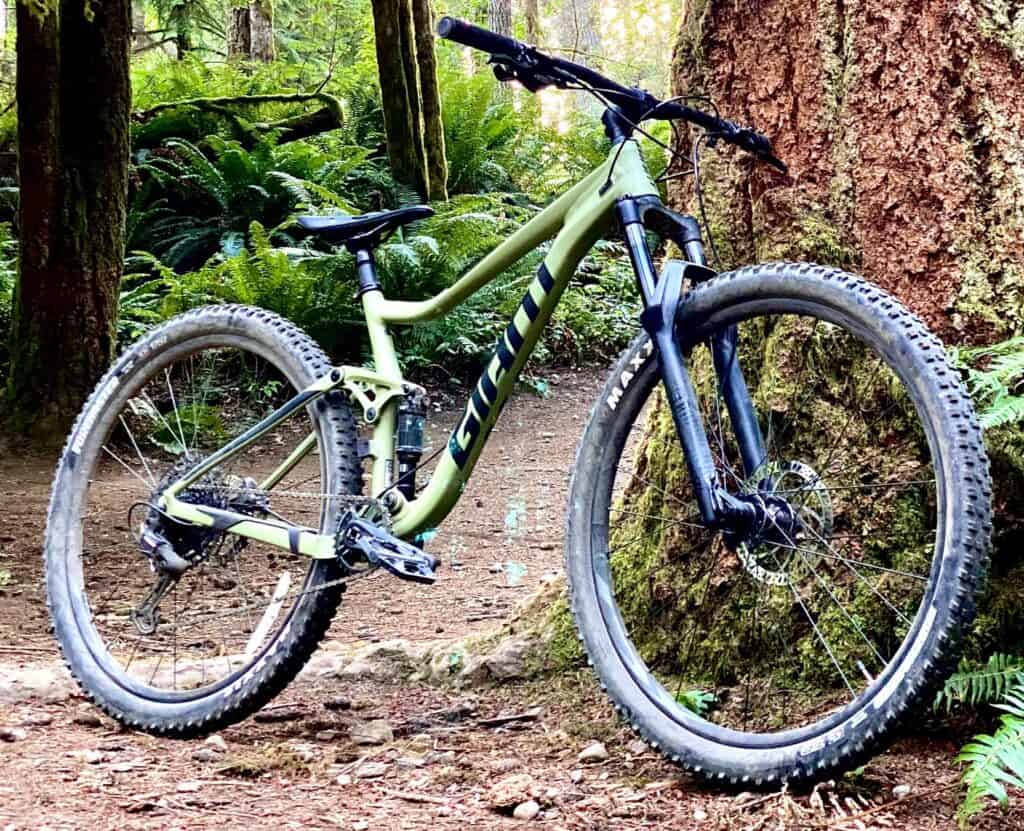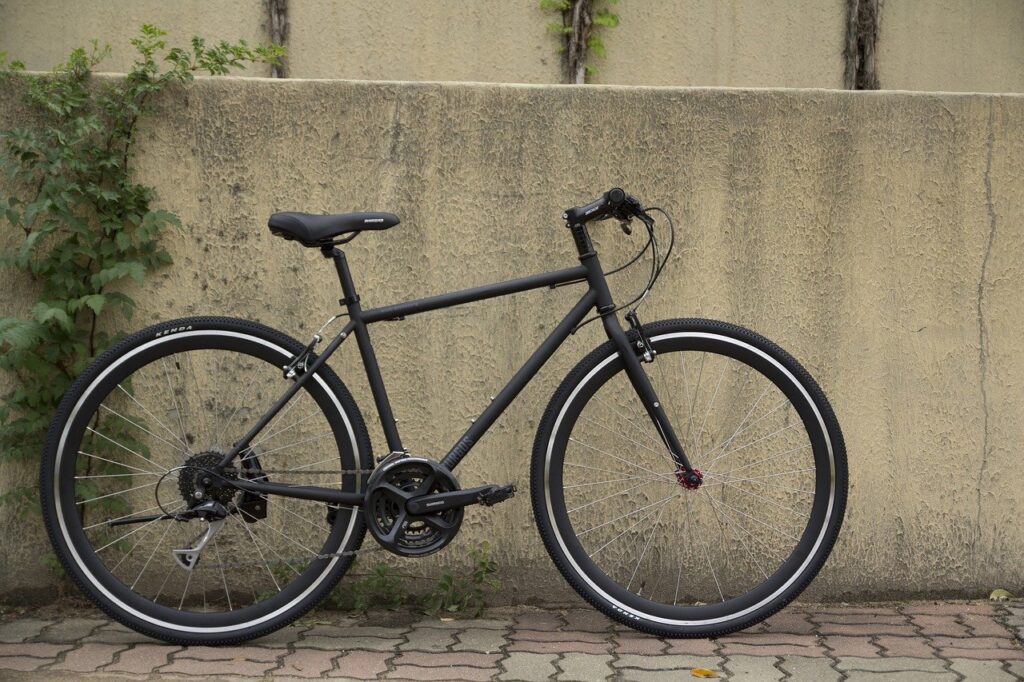Last updated: July 17th, 2023
Hybrid bikes draw inspiration from mountain bike design, so they overlap in function and appearance.
But they’re far from interchangeable.
Hybrids can wade into a bit of off-road riding, but they prioritize speed and efficiency on paved ground. On the other hand, mountain bikes can tackle far rougher terrain, but feel sluggish on pavement and smooth dirt.
As a rule of thumb:
- Buy a hybrid bike if you’ll ride mostly on pavement and smooth dirt/gravel paths.
- Buy a mountain bike if you’ll ride mostly on rougher trails, especially singletrack.
But if you plan on all the above, then it can be hard to choose between a hybrid bike vs. mountain bike. This article will share everything a new cyclist needs to know about how MTB and hybrids stack up!
This article might contain affiliate links. As a member of programs including Amazon Associates, I earn from qualifying purchases.
Hybrid vs. mountain bike speed
On pavement, mountain bikes are slower than hybrids due to higher rolling resistance. On trails, mountain bikes are generally faster since they roll more easily over obstacles.
Both styles generally put the rider in a moderate forward lean. That means similar aerodynamics and pedaling efficiency, which are two of the biggest factors in bicycle speed.
However, tire choice makes a large difference in speed.

Those low-pressure MTB tires with chunky tread are great at digging into soft ground and deforming (basically, squishing) to grab roots and rocks. All that traction adds up to a ton of rolling resistance, so if you don’t need that much traction for actual mountain biking, it’s markedly slower. What’s more, their extra width means more material and therefore more mass to start and keep rotating.
But when you do need that traction, mountain bikes are far faster. Their traction and suspension make it possible to hold a straight (or at least straighter) line over terrain that a hybrid just can’t handle.

Hybrids use thinner, firmer tires with smooth, subtle tread. Pavement is hard and porous, so, compared to dirt, it’s easy to grip even when wet. That means city-oriented hybrids can sacrifice off-road traction for on-road efficiency. (Granted, hybrid tires usually have some tread to support dirt-road rambling, but it’s nothing like the knobby rubber on mountain bikes.)
Is a dual-sport bicycle a hybrid or MTB?
Dual-sport bicycles are essentially hybrid bikes with front suspension and (usually) low- to mid-range components. They’re not significantly more capable off-road than a hybrid, but their suspension does take the edge off bumps.
It’s worth considering a dual-sport if you primarily ride bumpy but non-technical routes, like dirt paths or bad roads. Otherwise, a hybrid saves weight and money for smoother ground, and a MTB is tougher and more capable for rowdier trails.
Many people love them, and you may, too. But in my experience, they’re the worst of both worlds: the weight of an MTB and the terrain limitations of a hybrid.
Mountain bike vs. hybrid bike on trails
Hybrid bikes are well suited to smooth dirt and maintained gravel trails, but will struggle with obstacles like roots and rocks. Mountain bikes are better for more rugged trails thanks to improved traction, suspension, sturdier frames and parts, and (generally) low gearing for ultra-steep sections.
Certain individual hybrid work better than others, and some types of terrain will be a far better (or worse) experience than others. I’ve covered this in depth in my guide to riding hybrids off-road.
Can I ride a MTB on the road, or do I need a hybrid?
It’s perfectly OK to ride a mountain on the road, but it will be slower and will wear out your tires quickly. A hybrid is better suited to paved surfaces, where it’s almost as efficient as dedicated road bikes.
If you need to ride an MTB on the road regularly, then either replace the knobby tires with slick ones or keep a second wheelset with street-friendly tires.
Some MTBs lack high enough gearing for fast, open stretches of road. That’s usually not a problem on urban streets (since open stretches are rare) but it can be frustrating on dedicated bike paths.
There’s also a weight penalty with most mountain bikes. Their strength, suspension, and large tires are all helpful on trails, but they add mass that’s useless on the road.
Can I turn my mountain bike into a hybrid?
Yes, to some extent. It’s easy to make a rigid, vintage mountain bike feel like a hybrid by installing faster-rolling tires. It’s nearly impossible to turn a modern mountain bike into a convincing hybrid, since the geometry differences are enormous.
At a glance, hybrids are easy to mistake for vintage MTBs. Both have rigid frames and forks (in general), moderate tire width, and usually comparable frame geometry.
Modern MTBs have very long, slack geometry compared to hybrids. This is especially true of trail and enduro bikes, which eat up gnarly singletrack but have sluggish steering on asphalt. You’ll also need to ones have radically different geometry and fairly long-travel suspension
If you want to turn a MTB into a commuter, then the most important step is to swap the tires for faster-rolling and lighter ones with little to no tread. But if commuting is your goal, keep in mind that most MTBs lack rack and fender mounts. It’s hard to do without those essential commuting accessories, so you’ll need to get creative with mounting hardware, choose fenders that clip on, and/or settle for a backpack instead of a pannier.
All in all, most commuters will be faster and happier on a hybrid. While mountain bikes are usable for commuting, they’re often frustrating due to slow-rolling tires and a lack of rack/fender mounts. MTBs are worth considering in cities with extremely rough, pothole-ridden streets, but most commuters find hybrids more convenient.
Which kind should a beginner pick?
Hybrids and mountain bikes are equally good for beginners, since both have intuitive handling that doesn’t feel twitchy or precarious. Terrain is the most important factor, so get whichever is suited to where you expect to ride the most.
If you’re a beginner on a tight budget, then your money may go farther with a hybrid (like these terrific entry-level models). Good suspension adds multiple hundreds of dollars to the price tag, so consider starting with a hybrid if you aren’t certain where and how you’ll ride. You can always sell it to buy a mountain bike later on.
Which is better for exercise & weight loss?
It’s possible to get good exercise and lose weight on MTBs, hybrids, and any other kind of bike. It’s a matter of effort and diligence, not the bike itself.
That said, hybrids are arguably more popular for exercising and weight loss, since they shine on roads and paths, which most fitness cyclists prefer. (Off-road, all the obstacles tend to interrupt your cadence, which makes it difficult to maintain a certain exertion level or heart rate like on a stationary bike.)
So, while hybrids aren’t inherently superior for fitness and weight loss, they’re better suited to the places that most people enjoy for fitness and training rides.
Conclusion: is either better overall?
Each is far better for its intended purpose. Off-road, there’s no substitute for a mountain bike’s suspension, chunky tires, and forgiving geometry. On pavement, you’ll be grateful for a hybrid’s lower rolling resistance and ease of mounting accessories.
If you’re still unsure which to pick, then head down to your local bike shop and test-ride everything you can find!
There’s just no substitute for experiencing their handling, comfort level, and performance firsthand.
